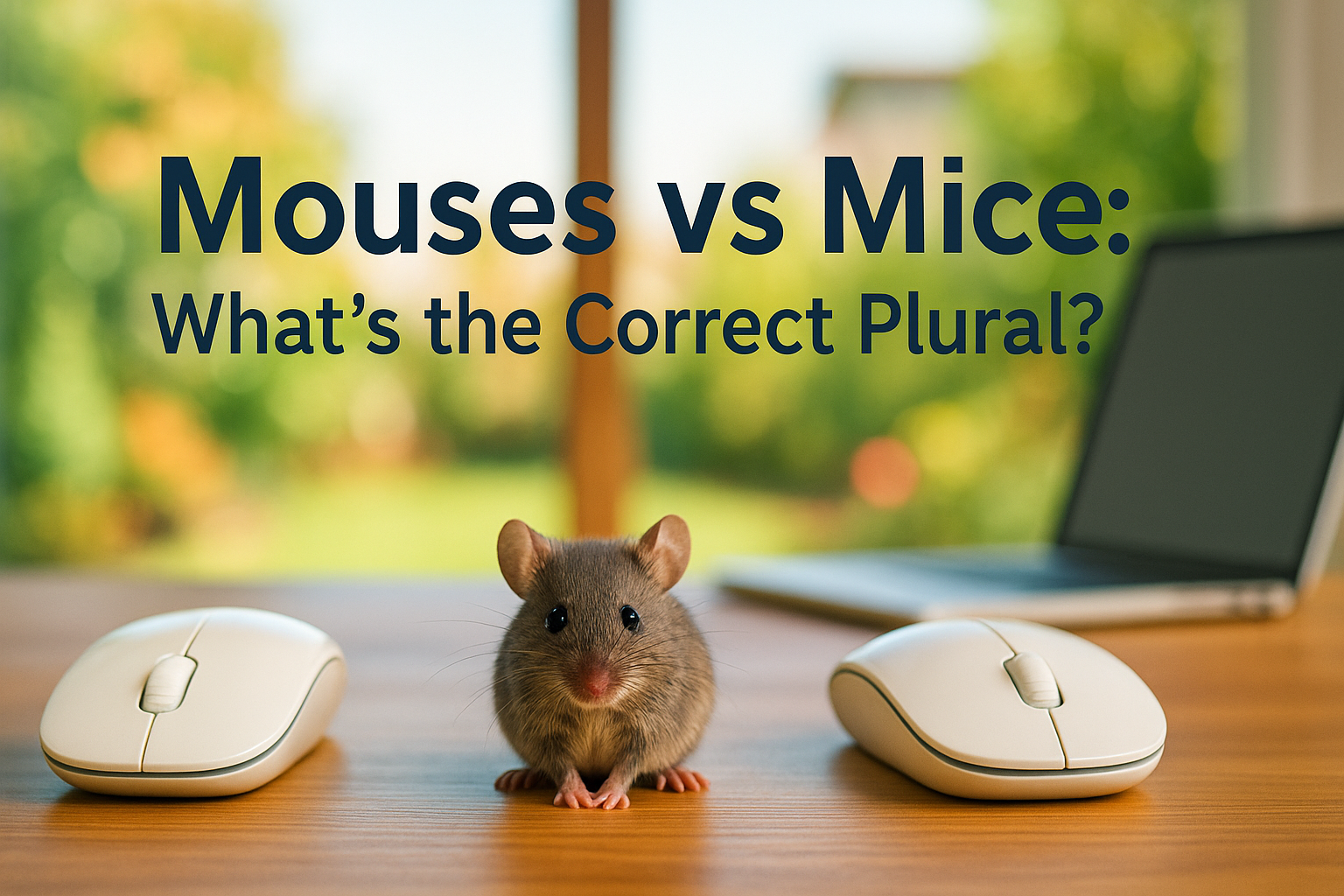When someone says they need two computer mouses, your ears might prick up. Yet, if they refer to two little furry mice, you probably don’t bat an eye. That’s because English treats these homonyms differently when it comes to pluralization. Cryptic? Maybe at first glance. But let’s demystify this with grammar clarity so you can write with confidence.
Understanding the Two Senses of “Mouse”
“Mouse” refers to both a small rodent and a computer device. Despite identical spelling and pronunciation, their plural forms differ:Up to Date or Up-to-Date: Which One to Use and Why?
- 🐁 Tiny animal (small rodent) → mice
- 🖱️ Computer device (handheld tool) → often mouses, though “mice” may appear
It’s a classic case of mice vs mouses in modern English. Both refer to plural forms, but each follows contextual logic rooted in grammar rules and language usage.
Read More About This Article: Up to Date or Up-to-Date: Which One to Use and Why?
The Animal Plural: Mice
When discussing the small rodent, the plural form is irregular, so we say mice.
Why “mice” and not “mouses”?
English features many irregular plurals—child → children, goose → geese, man → men, mouse → mice. These trace back to Old English roots like mūs (singular) and mȳs (plural). Linguistic heritage stuck, so mice remains the proper plural for animal mouse.
| Singular | Plural |
|---|---|
| mouse | mice |
| goose | geese |
| tooth | teeth |
| foot | feet |
There’s no alternative in standard English. If you’re writing about these furry creatures, use mice—always.
The Device Plural: Mouses
Enter the computer mouse: a handheld pointing device. Plural usage here gets sticky.
So, Is “mouses” Wrong?
Not anymore. In the tech world, mouses—though unconventional—has gained acceptance. Many manufacturers, guides, and tech writers use mouses to avoid confusion.
Search “two mouses” or “multiple mouses” in manuals from Apple, Logitech, and Microsoft—you’ll find real cases of accepted plural usage in digital input contexts.
Why the shift? Because mice used as plural raises eyebrow. Say “two mice,” and listeners might assume you’re talking rodents—not pointing devices.
Which Plural Is “Correct”?
For animals:
✅ Mice
This is the standard plural form for small rodents.
For devices:
✅ Mouses, though mice is occasionally used
Its adoption stems from the tech realm. It’s a valid plural, especially to signal you’re talking computer devices.
Why Two Plurals?
1. The rule of irregular nouns
“Mice” is steeped in history. English keeps certain odd plurals for legacy reasons. There’s no argument here—mice remains unambiguous and correct.
2. Context-driven adaptation
Language adapts. When a word gets repurposed—as happened with “mouse” in the digital age—new norms emerge. Mouses fits tech needs, while mice remains for animals.
Usage Comparison Table
| Context | Preferred Plural | Notes |
|---|---|---|
| Animal (rodents) | mice | Standard, time-honored irregular plural |
| Computer devices | mouses | Tech usage; clarifies meaning |
| Mixed context | – | Reword to avoid confusion (“rodents/devices”) |
Words Like “Mouse” with Dual Pluralization
Certain irregular words gain regular forms in modern usage:
- Index → indexes/indices
- Appendix → appendixes/appendices
- Formula → formulas/formulae
Like those examples, a word may
- have historical/informal plural (mice),
- evolve additional forms for clarity (mouses).
Real-World Examples: Mice and Mouses
- Animal Examples:
- “The lab contained 12 mice for the experiment.”
- “I saw two field mice chewing through the grain sack.”
- Device Examples:
- “We keep extra mouses in the IT closet.”
- “Plug in multiple mouses for the kiosk demo.”
🔍 In each scenario, the plural form clarifies the topic—whether living or digital.
Style Guide Perspectives
- Chicago Manual of Style: Recommends “mice” in both senses—but acknowledges tech-specific usage.
- AP Stylebook: Supports mouses if clarity demands it (especially in journalism).
- Merriam-Webster: Lists mice as plural but includes note on mouses usage.
- Microsoft and Apple: Feature documentation with “mouses” when referencing devices.
When to Choose Which Form
Pick mice if:
- You’re writing for general audiences unfamiliar with tech lingo
- Context clearly refers to rodents
- You follow strict traditional grammar
Pick mouses if:
- Audience expects technical clarity (IT, instructions, reviews)
- You want to avoid ambiguity with rodents
- Manufacturer or style guide uses it
Synonyms and Workarounds
Rather than choosing between mouses and mice, you can write around the problem:
- Pointing devices
- Computer mice (singular stays irregular)
- Digital input tools
These can be especially useful in mixed contexts to maintain clarity without fussing about plurals.
Avoiding Confusion in Writing
- Identify the subject: rodent or device?
- Choose the right plural accordingly.
- If you risk confusing readers, rewrite: “two pointing devices” or “a couple of rodents.”
- Consistency matters—especially in professional or published content.
Final Word on Mouses vs Mice
- Use mice for rodents. Always.
- Opt for mouses in technical or IT contexts.
- Don’t fear mixing forms—just use context to guide clarity.
- And if you’re ever uncertain? Ask yourself: am I feeding the cat or plugging into the computer?
Quick Plural Guide
| Subject | Plural | Notes |
|---|---|---|
| Animal/rodent | mice | Standard irregular plural |
| Computer mouse | mouses | Tech plural, or “mice” acceptable |
| Input devices (general) | pointing devices | Avoids confusion entirely |
Need More Grammar Fixes?
Let me know if you’d like help with other tricky plurals (like index/indexes or appendix/appendices). I’m here to keep your writing sharp, current, and clear.
Remember: Language is living. When words serve us better—especially in professional communication—it’s okay for their forms to evolve. The goal isn’t to be pedantic; it’s to be understood.

